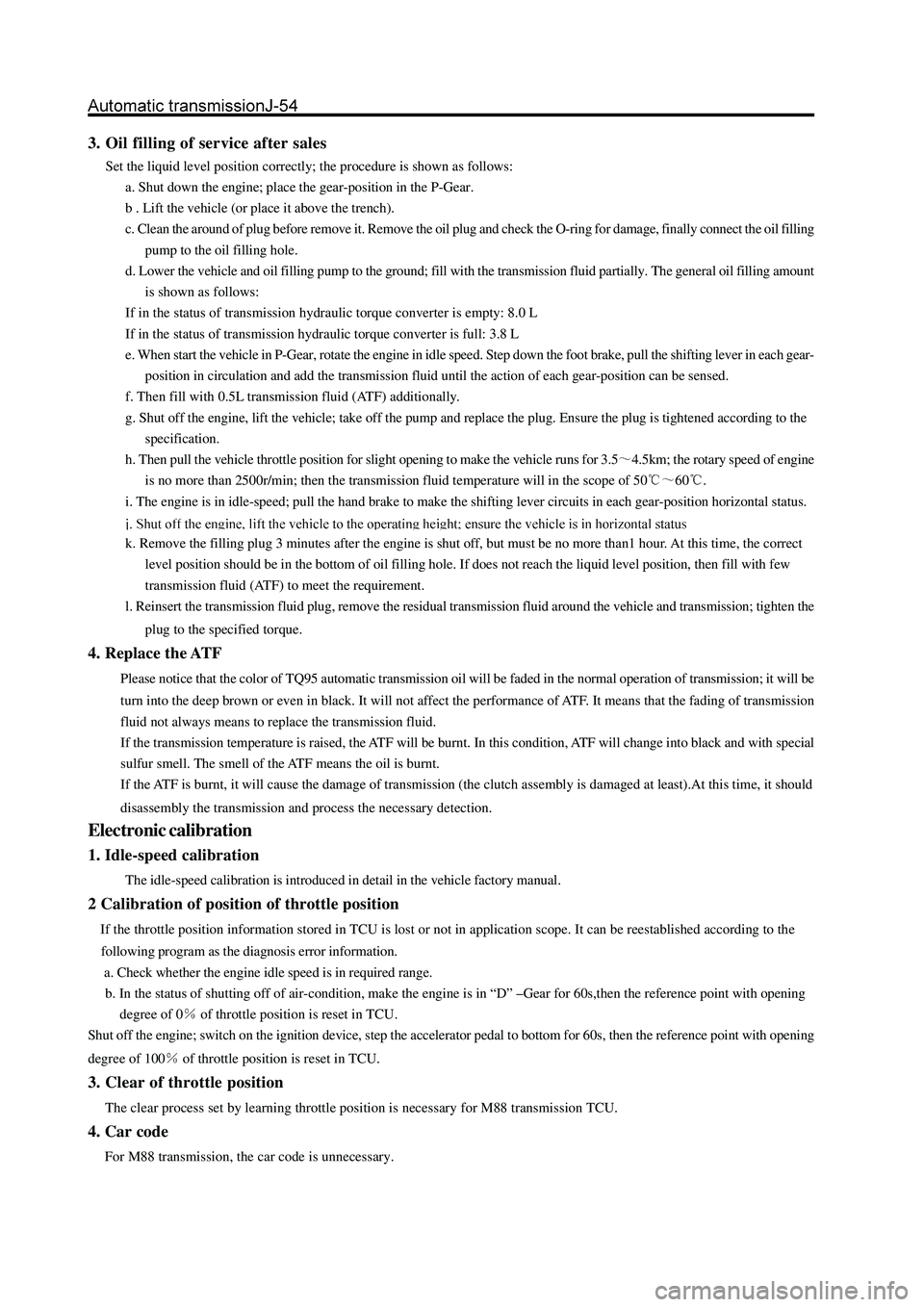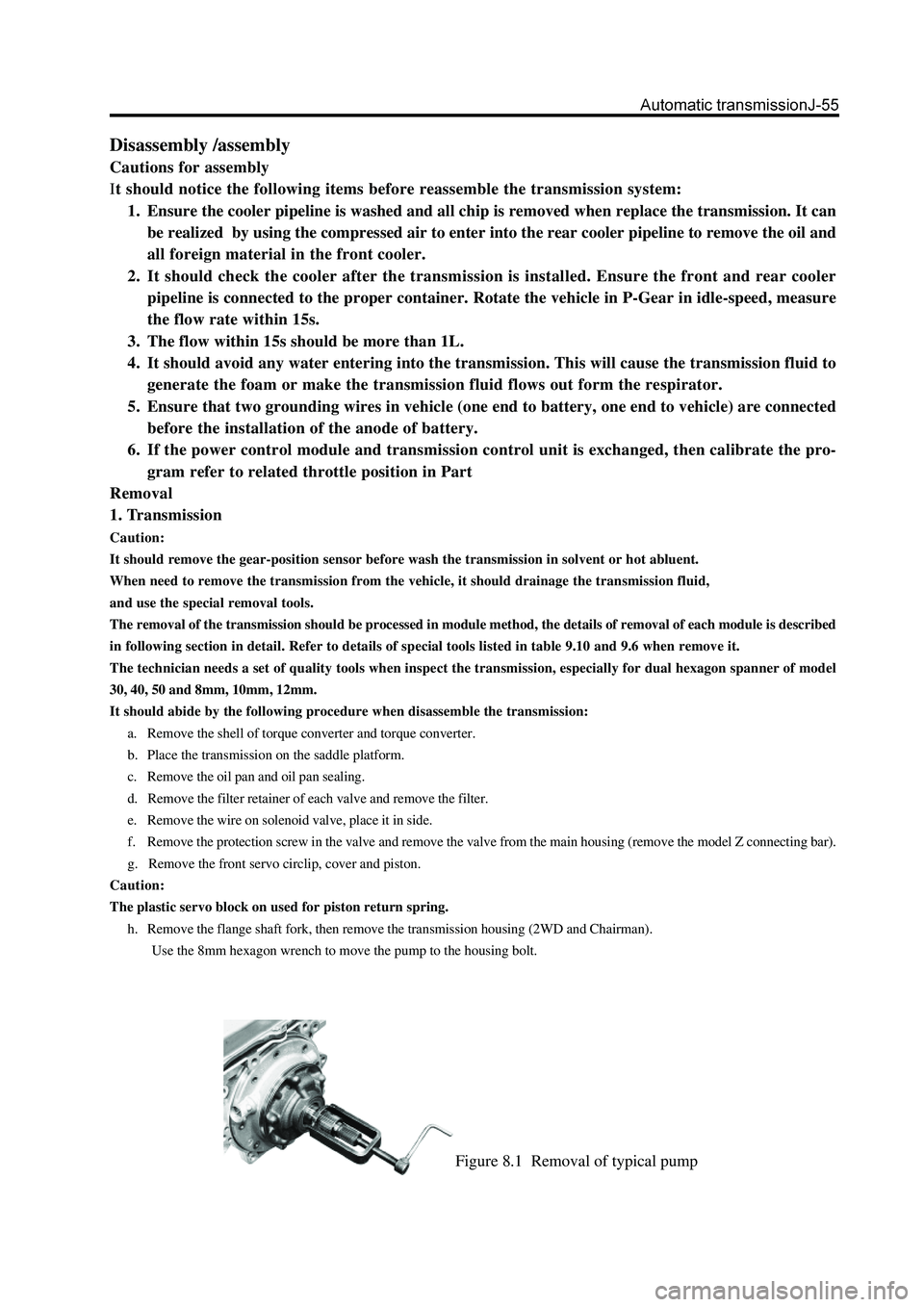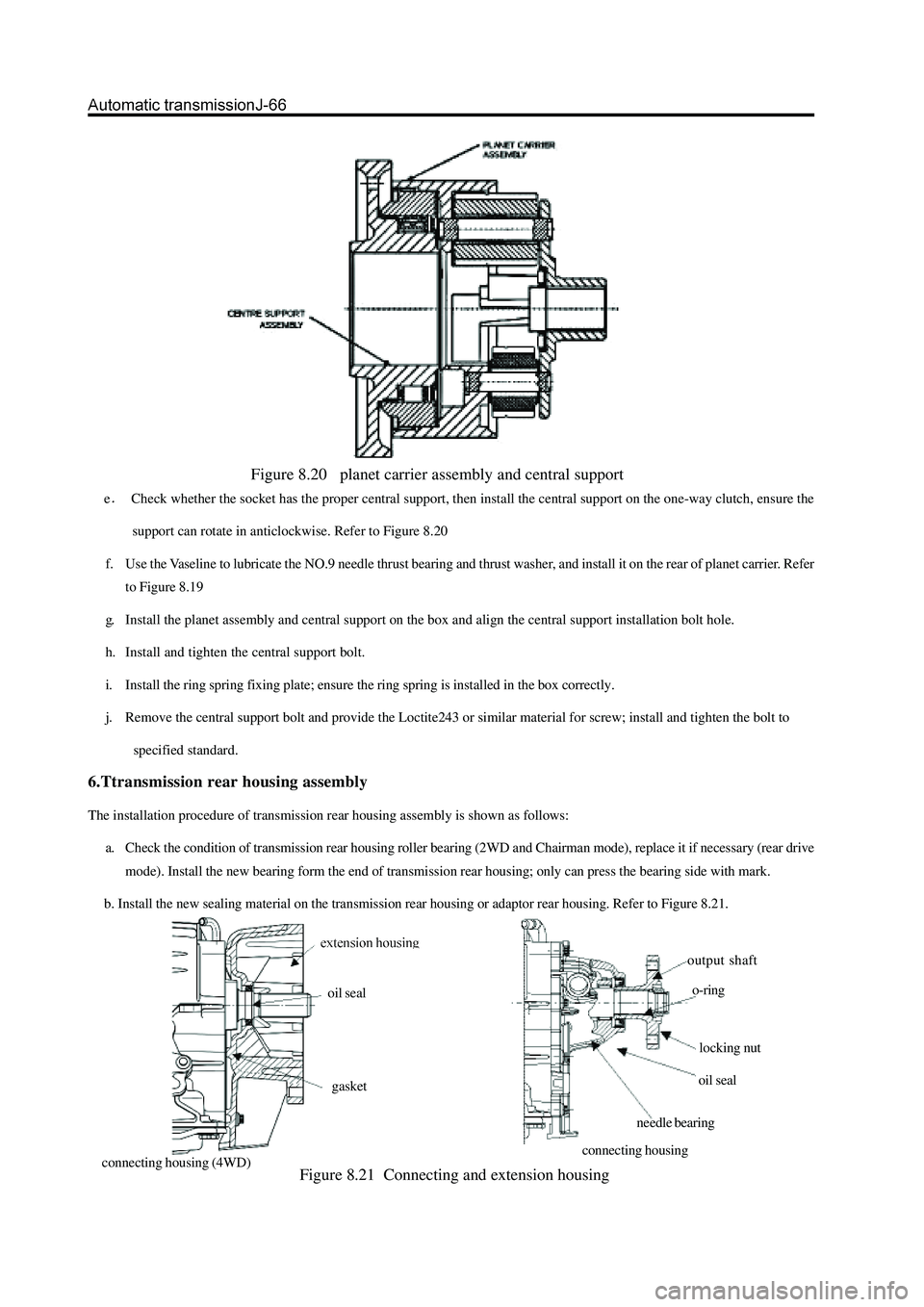2006 GREAT WALL HOVER oil
[x] Cancel search: oilPage 130 of 425

3. Oil filling of service after sales
Set the liquid level position correctly; the procedure is shown as follows:
a. Shut down the engine; place the gear-position in the P-Gear.
b . Lift the vehicle (or place it above the trench).
c. Clean the around of plug before remove it. Remove the oil plug and check the O-ring for damage, finally connect the oil filling
pump to the oil filling hole.
d. Lower the vehicle and oil filling pump to the ground; fill with the transmission fluid partially. The general oil filling amount
is shown as follows:
If in the status of transmission hydraulic torque converter is empty: 8.0 L
If in the status of transmission hydraulic torque converter is full: 3.8 L
e. When start the vehicle in P-Gear, rotate the engine in idle speed. Step down the foot brake, pull the shifting lever in each gear-
position in circulation and add the transmission fluid until the action of each gear-position can be sensed.
f. Then fill with 0.5L transmission fluid (ATF) additionally.
g. Shut off the engine, lift the vehicle; take off the pump and replace the plug. Ensure the plug is tightened according to the
specification.
h. Then pull the vehicle throttle position for slight opening to make the vehicle runs for 3.5
4.5km; the rotary speed of engine
is no more than 2500r/min; then the transmission fluid temperature will in the scope of 50
60.
i. The engine is in idle-speed; pull the hand brake to make the shifting lever circuits in each gear-position horizontal status.
k. Remove the filling plug 3 minutes after the engine is shut off, but must be no more than1 hour. At this time, the correct
level position should be in the bottom of oil filling hole. If does not reach the liquid level position, then fill with few
transmission fluid (ATF) to meet the requirement.
l. Reinsert the transmission fluid plug, remove the residual transmission fluid around the vehicle and transmission; tighten the
plug to the specified torque.
4. Replace the ATF
Please notice that the color of TQ95 automatic transmission oil will be faded in the normal operation of transmission; it will be
turn into the deep brown or even in black. It will not affect the performance of ATF. It means that the fading of transmission
fluid not always means to replace the transmission fluid.
If the transmission temperature is raised, the ATF will be burnt. In this condition, ATF will change into black and with special
sulfur smell. The smell of the ATF means the oil is burnt.
If the ATF is burnt, it will cause the damage of transmission (the clutch assembly is damaged at least).At this time, it should
disassembly the transmission and process the necessary detection.
Electronic calibration
1. Idle-speed calibration
The idle-speed calibration is introduced in detail in the vehicle factory manual.
2 Calibration of position of throttle position
If the throttle position information stored in TCU is lost or not in application scope. It can be reestablished according to the
following program as the diagnosis error information.
a. Check whether the engine idle speed is in required range.
b. In the status of shutting off of air-condition, make the engine is in “D” –Gear for 60s,then the reference point with opening
degree of 0
of throttle position is reset in TCU.
Shut off the engine; switch on the ignition device, step the accelerator pedal to bottom for 60s, then the reference point with opening
degree of 100
of throttle position is reset in TCU.
3. Clear of throttle position
The clear process set by learning throttle position is necessary for M88 transmission TCU.
4. Car code
For M88 transmission, the car code is unnecessary.
Page 131 of 425

Figure 8.1 Removal of typical pump
Disassembly /assembly
Cautions for assembly
It should notice the following items before reassemble the transmission system:
1. Ensure the cooler pipeline is washed and all chip is removed when replace the transmission. It can
be realized by using the compressed air to enter into the rear cooler pipeline to remove the oil and
all foreign material in the front cooler.
2. It should check the cooler after the transmission is installed. Ensure the front and rear cooler
pipeline is connected to the proper container. Rotate the vehicle in P-Gear in idle-speed, measure
the flow rate within 15s.
3. The flow within 15s should be more than 1L.
4. It should avoid any water entering into the transmission. This will cause the transmission fluid to
generate the foam or make the transmission fluid flows out form the respirator.
5. Ensure that two grounding wires in vehicle (one end to battery, one end to vehicle) are connected
before the installation of the anode of battery.
6. If the power control module and transmission control unit is exchanged, then calibrate the pro-
gram refer to related throttle position in Part
Removal
1. Transmission
Caution:
It should remove the gear-position sensor before wash the transmission in solvent or hot abluent.
When need to remove the transmission from the vehicle, it should drainage the transmission fluid,
and use the special removal tools.
The removal of the transmission should be processed in module method, the details of removal of each module is described
in following section in detail. Refer to details of special tools listed in table 9.10 and 9.6 when remove it.
The technician needs a set of quality tools when inspect the transmission, especially for dual hexagon spanner of model
30, 40, 50 and 8mm, 10mm, 12mm.
It should abide by the following procedure when disassemble the transmission:
a. Remove the shell of torque converter and torque converter.
b. Place the transmission on the saddle platform.
c. Remove the oil pan and oil pan sealing.
d. Remove the filter retainer of each valve and remove the filter.
e. Remove the wire on solenoid valve, place it in side.
f. Remove the protection screw in the valve and remove the valve from the main housing (remove the model Z connecting bar).
g. Remove the front servo circlip, cover and piston.
Caution:
The plastic servo block on used for piston return spring.
h. Remove the flange shaft fork, then remove the transmission housing (2WD and Chairman).
Use the 8mm hexagon wrench to move the pump to the housing bolt.
Page 137 of 425

Caution:
Some valves are pulled by the spring and may fall down form the valve.
m. Press down the plug of 4-3 sequence valve and take out the locking nut disc.
n. Take out the plug, valve and spring.
o. Press down the solenoid valve 5 gate. Remove the fixed pin, valve and spring.
Caution:
The valve is pulled by the spring and may fall down form the valve.
p . Press down the line pressure blow-off valve , then remove the fixed pin, disc (if proper) spring and valve.
q. Take out the roller pin and remove the spring and ball spool detection valve adjacent BAR.
Assembly
The transmission is assembled in the method of module. The detailed assembly process of each module is described in the
following chapter in detail.
Refer to Table 8.1 (end of section 8.3) for the description of used torque specification. The Table 9.10 in section 9.6 describes
the necessary special tools for assembly.
The technician also needs to select the quality Torx tools, especially for the two-screw socket wrench with code of 40, 50,
8mm,10mm and 12mm to detect the transmission completely.
1.Transmission
Caution:
Ensure the BIR retainer is proper for the case (otherwise, the valve will damage the separation disk).
Ensure the E clip is installed on the cross shaft.
Ensure all parts of parking machine can operate normally.
The assembly procedure of transmission is shown as follows:
a. Place the upper transmission on the platform upwardly and place it on the transmission bracket.
b. Install all accessories, bolts and bleed devices. Paint the sealant on the sealing place. Tighten all components according
to the specification. Ensure the cleanness of all bleed devices. Ensure the rear oil filling nozzle of housing is correct and
without blocking material. Refer to Figure 8.19.
c. Assemble the BIR valve and spring; ensure the retainer is installed correctly, refer to Figure
8.10. Ensure the
retainer is fixed in the groove completely.
d. Install the rear servo bar and pin shaft. Refer to Figure 8.11.
Caution: Ensure the crown bar can rotates freely.
Page 139 of 425

Figure 8.15 manual-operated valve brake lever
k. Install the manual-operated valve detent connecting rod (shown as Figure 8.15), align it with the cross shaft hole.
l. Push the shaft by the positioning operating lever, until start from one side of box operating lever.
m. Use the special tools to install the operating lever drive bolt on the shaft, and ensure the adaptor covers the bolt.
n. Press the bolt into the shaft until the tools reaches the bottom.
o. Take out the tools and install the spring fixing ring spring on the shaft
p . Use the tools to install the new cross shaft seal.
q. Install the Gear-position sensor on the box; install the screw according to the specified torque. Use the tools to press the bolt
on the shaft.
r. Check the connection of wire bunch port completely to ensure the normal operation.
s. Install the wire bunch and install the connecting point of solenoid valve 7 and ring flange matched to the pump. Refer to Figure
8.16. The connecting wire of solenoid valve 7 is organized under the parking lever and in box cross shaft.
t . Install the 10-pin connecting socket in the box, ensure the flange of connecting socket matches to the notch on box.
u. Pull out the wire bunch part form the box and prohibition switches; install the 10-pin connecting socket on the wire bunch
bracket (only for rear-wheel drive mode).
Figure 8.16 Connecting position of coil 7Figure 8.17 Installation of 10-pin
connecting plug
Page 140 of 425

2.output shaft and gear assembly
The assembly procedure of output shaft and gear assembly (Refer to Figure 8.19),is shown as follows:
a. Check the output shaft bush for damage, replace it if necessary.
b. Check the parking detent on the ring gear for damage ; replace it if necessary.
c. Check the sealing ring groove for damage.
d. Use the automatic transmission liquid to lubricate the gasket.
e. Place the scarfing notch upwardly and install the sealing ring on the output shaft.
f. If has been removed., it should use the ring spring for reinforcement when install the ring gear on the output shaft. Ensure the
ring spring is fixed in the groove.
g. Use the Vaseline oil for lubrication; install the thrust bearing assembly NO.10 on the output shaft.
h. It should be carefully when install the output shaft on the box to avoid the damage of sealing ring.
3. Rear brake belt assembly
The assembly procedure of rear brake belt assembly (Refer to Figure 8.18) is shown as follows:
a. Check the rear brake belt for leakage or damage; check its corresponding bush and metal back .
Figure 8.18 Rear servo and brake belt
b. Install the reaction reinforcement bar on the main box, need not shim.
Caution:
Place the new brake belt in the automatic transmission liquid for about 5 minutes before install it.
c. It should be careful when install the rear brake belt on the transmission. Ensure the brake belt is installed on the correct
position.
d. Install the application support bar on the rear brake belt, then connect it to the servo motor
bar.
e. Install the cam disc and tighten the screw according to the instruction.
Page 142 of 425

connecting housing (4WD)connecting housing
Figure 8.20 planet carrier assembly and central support
eCheck whether the socket has the proper central support, then install the central support on the one-way clutch, ensure the
support can rotate in anticlockwise. Refer to Figure 8.20
f. Use the Vaseline to lubricate the NO.9 needle thrust bearing and thrust washer, and install it on the rear of planet carrier. Refer
to Figure 8.19
g. Install the planet assembly and central support on the box and align the central support installation bolt hole.
h. Install and tighten the central support bolt.
i. Install the ring spring fixing plate; ensure the ring spring is installed in the box correctly.
j. Remove the central support bolt and provide the Loctite243 or similar material for screw; install and tighten the bolt to
specified standard.
6.Ttransmission rear housing assembly
The installation procedure of transmission rear housing assembly is shown as follows:
a. Check the condition of transmission rear housing roller bearing (2WD and Chairman mode), replace it if necessary (rear drive
mode). Install the new bearing form the end of transmission rear housing; only can press the bearing side with mark.
b. Install the new sealing material on the transmission rear housing or adaptor rear housing. Refer to Figure 8.21.
Figure 8.21 Connecting and extension housing
output shaft
o-ring
locking nut
oil seal
needle bearing oil seal
gasket
Page 143 of 425

Caution:
Do not use the Vaseline to fix the washer.
c. Install the transmission rear housing or adaptor rear housing with the new washer.
Caution:
Refer to the description in section 8.3.17 related installation of output flange assembly (rear wheel drive).
d. Install the transmission rear housing (rear wheel drive) or adaptor rear housing (4WD ) and tighten the bolt.
e. Provide the Loctite202 or equivalent sealant to the rear housing or connector and process the installation. Ensure the bolt is
tightened according to the specification. (Refer to Figure 8.1)
7. Front servo assembly
Caution:
Ensure the front servo clamp ring is installed correctly; ensure the ring spring and spark gap points to the bottom. Refer
to Figure 8.22.
The assembly procedure of front servo assembly (Refer to Figure 8.22) is shown as follows:
a. Use the automatic transmission liquid to lubricate the housing O-ring and install it on the housing.
b. Use the automatic transmission liquid to lubricate the housing O-ring and install it on the piston.
c. Install the piston, brake lever, spring, washer, base and fixing ring.
d. Install the piston brake lever assembly on the front servo housing.
e. Install the front servo plug and spring in the box.
f. Install the front servo assembly in the box.
g. Press down the servo housing and install the fixing ring spring of servo housing. Align the spark gap and coil track and ensure
it is installed in the groove properly. Figure 8.22 front servo and brake belt
8. Brake belt assembly
The assembly process of brake belt assembly is shown as follows:
a. Install the reaction reinforcement lever on the housing.
b. Check the brake belt for crack or damage; check the bush and metal back.
c. Install the support retainer on the brake belt (Refer to Figure 8.23).Note that the later transmission modes will not adopt the
support retainer.
Caution:
Place the new brake belt in the automatic transmission liquid for about 5 minutes before install it.
Page 144 of 425

Figure 8.23 Installation of brake belt press lever
d. Install the brake belt on the transmission, ensure it is installed on the correct position.
e. Install the reaction support on the fixing plate and connect it to the brake belt and reinforcement lever. Install the application
support on thea fixing plate and connect it to the brake belt and servo piston bar.
9.C2/clutch C4 assembly
Caution:
Check the piston for crack, especially for piston C2.
Must not mix the clutch piston out and back spring.
Ensure the correct installation of clip ring
The assembly procedure of C2/clutch C4 assembly (refer to 8.24) is shown as follows:
a. Ensure the cleanness of internal oil inlet of cylinder; check the discharge outlet of piston C2 for cleanness; use the transmission
liquid to lubricate the O-ring.
Caution:
The O-ring must not be winded in groove.
Figure 8.24 Typical C2/C4clutch assembly
b. Install the small O-ring in the inner groove; install the large O-ring in the external groove of piston; check the discharge outlet
of C4 piston for cleanness.
c. Use the transmission liquid to lubricate the O-ring; install the small O-ring in the inner groove; install the large O-ring in the
external groove of piston.
d. Make the C2/clutch C4 hole face upwardly; install the clutch cylinder; place the C4 piston in the original position proper for
C2 piston during the calibration..
e. Install the C2/C4 piston assembly on the cylinder; ensure the external hole of cylinder align with the discharge outlet of piston,
until the external diameter of C2 piston enters into the internal diameter of cylinder.